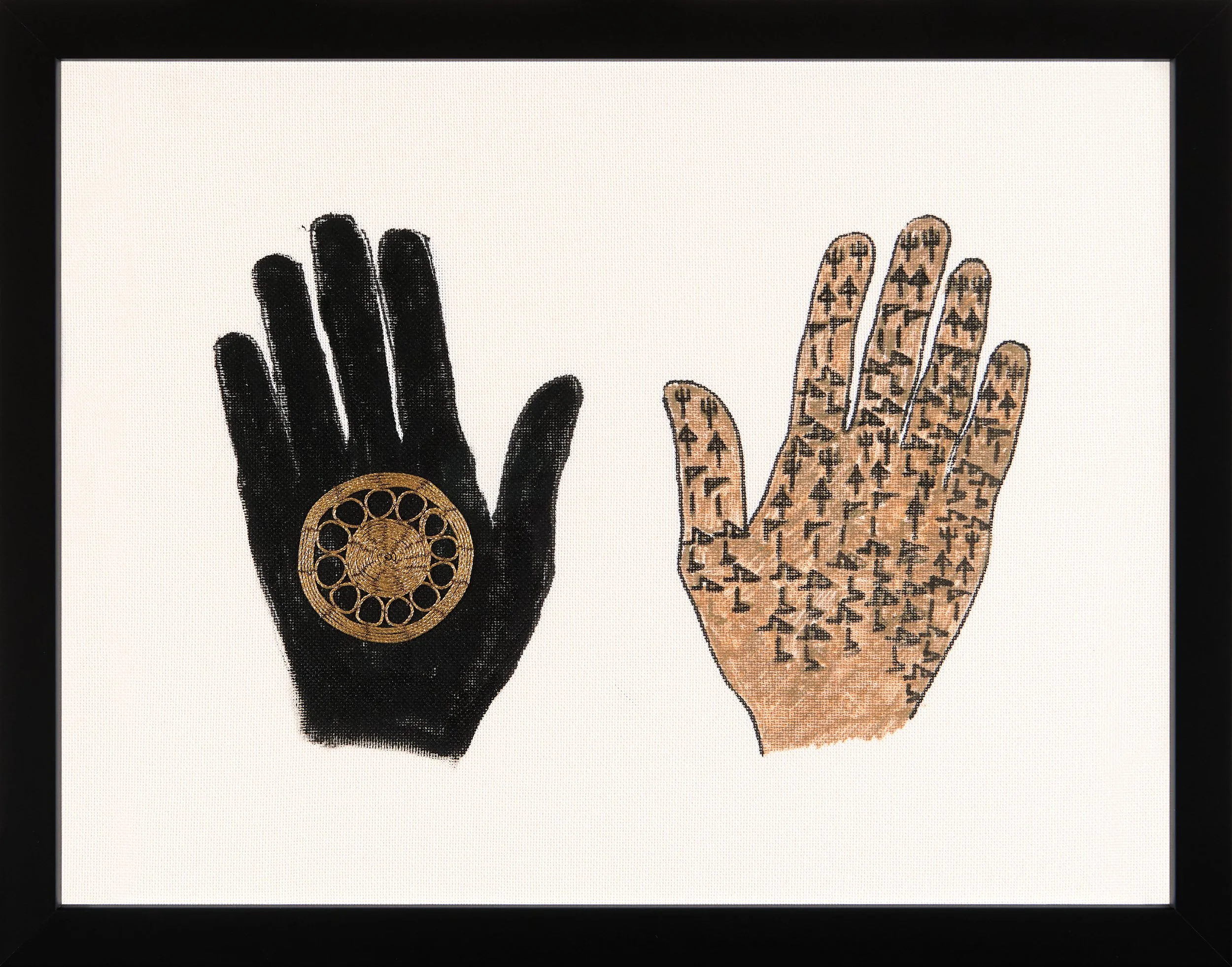AMULET (The Body Language series)
The Body Language series examines how energy flows through the body in Islamic prayer postures. I simplified the postures into the glyphs, like on the golden hand in this piece. The hands are placed in sujood, or prostration, where the heart becomes positioned above the head. The black hand has couching embroidery (employing the Palestinian tahriri stitch from Bethlehem) that forms a protective eye. Inside the eye around the twelve rings of the spiral, there are twelve circles, a significant number in different sacred, spiritual, and cosmological practices. The protective hands are relevant symbolically for the five fingers representing the five daily prayers and for communicating, channeling, and receiving source energy.
THE WATER SPRING
Cotton thread on linen (31x31 cm)
As Israelis splash around in their swimming pools, irrigate their farms, and boast about making the desert bloom, access to water for Palestinians is a full-blown crisis with Israel controlling and restricting all the water and water-related infrastructure in the West Bank and Gaza. In Gaza, ninety to ninety-five percent of water is contaminated and unfit for human consumption. With ninety percent of the West Bank Aquifer diverted to Israel, settlers in the West Bank consume four times the amount of water as Palestinians (consuming less than the World Health Organization’s daily minimum recommendation). Palestinians have restricted access to the remaining ten percent, intentionally destroying Palestinian agriculture and economy. This piece describes Palestine's water crisis using the same medium and symbolic language of Palestinian embroidery worn by Palestinian farmer and villager women to express their localized identities and personal stories. The disappearing Palestinian embroidery motifs of regional plants, barbed wire, and water spring represent the devastating effect on agriculture in the West Bank caused by the forced separation and restriction to clean and safe water sources. Here is a peek into the near and ominous future where Israel continues to deny Palestinians their human right to water for agriculture and domestic use, adding climate refugees to the pre-existing Palestinian refugee crisis while further aiding in the ethnic cleansing of the indigenous population.
ENTANGLEMENT
Cotton thread on cotton fabric (15 x 30 cm)
The theory of quantum entanglement states that even if two particles are physically separated, they can still be connected. Karmic entanglement also speaks of the connection, regardless of space or time, between individuals, an individual to a group of people, or an individual to a belief. In this piece, traditional rules of the symbolic language of Palestinian embroidery are broken and a new translation of the motif is formulated. By understanding entanglement in visual or symbolic terms, an opportunity is created to consider the connecting force or frequency and recognise it as love. Threads emerge from and connect to the four squares centred in each motif, resembling the four chambers of the heart, removing the illusion of separateness while leaving behind the ultimate essence of oneness.
Exhibited in the Made In Tashkeel exhibition at Tashkeel in Dubai, 2019.
ARTICLE 5
mixed media on embroidery fabric
“No one shall be subjected to torture or to cruel, inhuman or degrading treatment or punishment.”
This is my block in the UDHR Quilt project led by Tal Fitzpatrick and Stephanie Dunlap to celebrate the Universal Declaration of Human Rights and promote awareness of violations happening all over the world. On my block of the quilt, I have hand embroidered the traditional Palestinian motif of the star of Bethlehem across the sky. Article 5 is stenciled on the separation wall representing the significance of graffiti and street art as a tool of communication in the public sphere in Palestine. More traditional Palestinian embroidery, such as Cyprus trees and ‘the walls of Jerusalem’ motifs run along the bottom of the panel under the wall representing the Palestinian land. Although Israel fails to comply with most of the articles of the Universal Declaration of Human rights, the violation of Article 5 is a succinct summation of the Israeli occupation of the Palestinian people on their native land since 1948.
It is included as a block on one of the four quilts of the “The #UDHRquilt Project: Craftivism, Quilts & Human Rights” in the Museum of Australian Democracy’s permanent collection.
THERE'S NO PLACE LIKE HOME
mixed media on embroidery fabric
The right of return home to Palestine is a shared dream of the Palestinian diaspora collective. Here, the Palestinian woman wearing a traditional embroidered dress and red shoes references Dorothy in ruby red slippers from The Wizard of Oz returning home to Kansas after the catastrophe of the tornado and her displacement in Oz. The Palestinian house motif is hand-embroidered, intentionally left empty, creates the yellow brick road in the background that our Dorothy follows with blind faith and hope for returning home.




